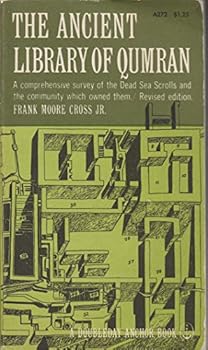The Ancient Library of Qumran
Select Format
Select Condition 
Book Overview
Since the first publication of this book in 1959 it has become a classic: It is a sober and objective account by a scholar who has taken a leading part in the editing and evaluation of the Qumran... This description may be from another edition of this product.
Format:Paperback
ISBN:B000ILI9XG
Release Date:January 1961
Publisher:Anchor
Length:260 Pages
Weight:0.40 lbs.
Customer Reviews
1 rating
An authoritative introduction
Published by Thriftbooks.com User , 19 years ago
Frank Moore Cross is one of the early scroll scholars, and his book, 'The Ancient Library of Qumran' was one of the earliest popular publications of the discovery and contents of the scrolls. Originally published less than ten years after the scroll discoveries in 1947/48, this volume has proven popular enough to stay in print, being updated several times. This latest edition was published in 1995, with updated material as the scroll processes continue.Cross's first chapter examines the discovery of the scrolls, including some of the intrigues of the bedouins and antiquities dealers in the West Bank region, and subsequent explorations and excavations that revealed more caves in the Qumrani region with scrolls and scroll fragments. Cross introduces a few of the key scroll players (Roland de Vaux among them) as well as the beginning process of reconstruction. In his supplement for chapter 1, updating materials, he discusses the many publications now available for the scrolls.The second chapter introduces the Essenes, the group of people responsible for the majority of the scrolls, according to the primary interpretation by the scroll scholars. These people are still enigmatic - references to them are few and far between in the ancient world, and the scrolls do not specifically identify them as the scribes and authors of the scrolls, so this interpretation still has some controversy attached to it.Chapter three develops some of the most interesting and controversial characters discovered in the texts of the scrolls - the Teacher of Righteousness and the Wicked Priest. Cross holds to the most widely held interpretation of these figures, in that the Teacher of Righteousness was the founder or leader of the Qumrani Essene community, and the Wicked Priest was the Jerusalem Temple priest who persecuted the Essenes. Other interpretations (that Jesus was the Teacher of Righteousness and Paul was the Wicked Priest; that John the Baptist was the Teacher of Righteousness and Jesus was the Wicked Priest, etc.) are not really addressed here, but are taken up again in a later chapter..The fourth chapter looks at the texts of the Hebrew Bible/Old Testament found among the scrolls - the largest body of material in the scrolls are texts of scripture. There are variations and differences, some of which can be attributed to scribal error (mis-copying), but others not so. The Torah is the largest body of scrolls by far; the integrity of the current Torah texts is reaffirmed to a large extent given these new scrolls, as the differences are on a percentage basis very small. In the end, every book of the Hebrew Bible has been found among the scrolls with the possible exception of Esther. This chapter is rather technical in terms of textual studies.The fifth chapter explores the early scroll scholars ideas of possible connections between the Essenes and the early Christian church. The apocalyptic nature of the Essenes and the enigmatic figures are compared with




